Increased Gene Expression of C1orf74 Is Associated with Poor Prognosis in Cervical Cancer
Abstract
1. Introduction
2. Materials and Methods
2.1. Expressions of Genes Associated with Survival in Cervical Cancer Patients
2.2. Expression Level of the C1orf74 Gene in Different Types of Cancers
2.3. Patient Samples
2.4. Cell Culture
2.5. DNA Isolation, HPV Detection and Genotyping
2.6. RNA Isolation, Reverse Transcription, and Real-Time Quantitative Polymerase Chain Reaction (RT-qPCR)
2.7. Promoter Methylation Analysis of C1orf74
2.8. Survival Analysis
2.9. Interaction Network and Functional Enrichment Analyses of C1orf74-Correlated Genes
3. Results
3.1. Expression of Genes Associated with Survival in Cervical Cancer
3.2. Expression of C1orf74 in Cervical Cancer
3.3. C1orf74 Expression in Cervical Cancer Cell Lines and Patient Tumor Samples
3.4. Promoter Methylation Analysis of C1orf74 in Cervical Cancer
3.5. Survival Analysis
3.6. Interaction Network, Prognostic Impact, and Functional Enrichment of C1orf74-Correlated Genes in Cervical Cancer
4. Discussion
5. Conclusions
Supplementary Materials
Author Contributions
Funding
Institutional Review Board Statement
Informed Consent Statement
Data Availability Statement
Acknowledgments
Conflicts of Interest
References
- Sung, H.; Ferlay, J.; Siegel, R.L.; Laversanne, M.; Soerjomataram, I.; Jemal, A.; Bray, F. Global Cancer Statistics 2020: GLOBOCAN Estimates of Incidence and Mortality Worldwide for 36 Cancers in 185 Countries. CA Cancer J. Clin. 2021, 71, 209–249. [Google Scholar] [CrossRef] [PubMed]
- Hu, Z.; Ma, D. The Precision Prevention and Therapy of HPV-Related Cervical Cancer: New Concepts and Clinical Implications. Cancer Med. 2018, 7, 5217–5236. [Google Scholar] [CrossRef] [PubMed]
- Zhang, S.; Xu, H.; Zhang, L.; Qiao, Y. Cervical Cancer: Epidemiology, Risk Factors and Screening. Chin. J. Cancer Res. 2020, 32, 720–728. [Google Scholar] [CrossRef] [PubMed]
- Walter, F.M.; Mwaka, A.D.; Neal, R.D. Achieving Earlier Diagnosis of Symptomatic Cervical Cancer. Br. J. Gen. Pract. 2014, 64, 495–496. [Google Scholar] [CrossRef] [PubMed][Green Version]
- Dereje, N.; Addissie, A.; Worku, A.; Assefa, M.; Abraha, A.; Tigeneh, W.; Kantelhardt, E.J.; Jemal, A. Extent and Predictors of Delays in Diagnosis of Cervical Cancer in Addis Ababa, Ethiopia: A Population-Based Prospective Study. JCO Glob. Oncol. 2020, 6, 277–284. [Google Scholar] [CrossRef] [PubMed]
- Jain, A.; Ganesh, B.; Bobdey, S.C.; Sathwara, J.A.; Saoba, S. Sociodemographic and Clinical Profile of Cervical Cancer Patients Visiting in a Tertiary Care Hospital in India. Indian J. Med. Paediatr. Oncol. 2017, 38, 291–295. [Google Scholar] [CrossRef] [PubMed]
- Cervical Cancer Prognosis and Survival Rates—NCI. Available online: https://www.cancer.gov/types/cervical/survival (accessed on 12 September 2023).
- Musunuru, H.B.; Pifer, P.M.; Mohindra, P.; Albuquerque, K.; Beriwal, S. Advances in Management of Locally Advanced Cervical Cancer. Indian J. Med. Res. 2021, 154, 248–261. [Google Scholar] [CrossRef] [PubMed]
- Cai, L.; Hu, C.; Yu, S.; Liu, L.; Yu, X.; Chen, J.; Liu, X.; Lin, F.; Zhang, C.; Li, W.; et al. Identification and Validation of a Six-Gene Signature Associated with Glycolysis to Predict the Prognosis of Patients with Cervical Cancer. BMC Cancer 2020, 20, 1133. [Google Scholar] [CrossRef]
- Lin, M.; Ye, M.; Zhou, J.; Wang, Z.P.; Zhu, X. Recent Advances on the Molecular Mechanism of Cervical Carcinogenesis Based on Systems Biology Technologies. Comput. Struct. Biotechnol. J. 2019, 17, 241–250. [Google Scholar] [CrossRef]
- Huang, L.; Zheng, M.; Zhou, Q.-M.; Zhang, M.-Y.; Yu, Y.-H.; Yun, J.-P.; Wang, H.-Y. Identification of a 7-Gene Signature That Predicts Relapse and Survival for Early Stage Patients with Cervical Carcinoma. Med. Oncol. 2012, 29, 2911–2918. [Google Scholar] [CrossRef]
- Fu, H.-C.; Chuang, I.-C.; Yang, Y.-C.; Chuang, P.-C.; Lin, H.; Ou, Y.-C.; Chang Chien, C.-C.; Huang, H.-S.; Kang, H.-Y. Low P16INK4A Expression Associated with High Expression of Cancer Stem Cell Markers Predicts Poor Prognosis in Cervical Cancer after Radiotherapy. Int. J. Mol. Sci. 2018, 19, 2541. [Google Scholar] [CrossRef] [PubMed]
- Lim, H.-Y.; Sohn, I.; Deng, S.; Lee, J.; Jung, S.H.; Mao, M.; Xu, J.; Wang, K.; Shi, S.; Joh, J.W.; et al. Prediction of Disease-Free Survival in Hepatocellular Carcinoma by Gene Expression Profiling. Ann. Surg. Oncol. 2013, 20, 3747–3753. [Google Scholar] [CrossRef] [PubMed]
- Huang, L.; Zheng, M.; Zhou, Q.-M.; Zhang, M.-Y.; Jia, W.-H.; Yun, J.-P.; Wang, H.-Y. Identification of a Gene-Expression Signature for Predicting Lymph Node Metastasis in Patients with Early Stage Cervical Carcinoma. Cancer 2011, 117, 3363–3373. [Google Scholar] [CrossRef] [PubMed]
- Cancer Genome Atlas Research Network. Integrated Genomic and Molecular Characterization of Cervical Cancer. Nature 2017, 543, 378–384. [Google Scholar] [CrossRef] [PubMed]
- Li, Z.; Chen, J.; Zhao, S.; Li, Y.; Zhou, J.; Liang, J.; Tang, H. Discovery and Validation of Novel Biomarkers for Detection of Cervical Cancer. Cancer Med. 2021, 10, 2063–2074. [Google Scholar] [CrossRef] [PubMed]
- Martin, C.M.; Astbury, K.; McEvoy, L.; O’Toole, S.; Sheils, O.; O’Leary, J.J. Gene Expression Profiling in Cervical Cancer: Identification of Novel Markers for Disease Diagnosis and Therapy. Methods Mol. Biol. 2009, 511, 333–359. [Google Scholar] [CrossRef] [PubMed]
- Zhu, X.; Li, S.; Luo, J.; Ying, X.; Li, Z.; Wang, Y.; Zhang, M.; Zhang, T.; Jiang, P.; Wang, X. Subtyping of Human Papillomavirus-Positive Cervical Cancers Based on the Expression Profiles of 50 Genes. Front. Immunol. 2022, 13, 801639. [Google Scholar] [CrossRef] [PubMed]
- Lee, S.-Y.; Chae, D.-K.; Lee, S.-H.; Lim, Y.; An, J.; Chae, C.H.; Kim, B.C.; Bhak, J.; Bolser, D.; Cho, D.-H. Efficient Mutation Screening for Cervical Cancers from Circulating Tumor DNA in Blood. BMC Cancer 2020, 20, 694. [Google Scholar] [CrossRef]
- Liu, J.; Li, Z.; Lu, T.; Pan, J.; Li, L.; Song, Y.; Hu, D.; Zhuo, Y.; Chen, Y.; Xu, Q. Genomic Landscape, Immune Characteristics and Prognostic Mutation Signature of Cervical Cancer in China. BMC Med. Genom. 2022, 15, 231. [Google Scholar] [CrossRef]
- UALCAN. Available online: https://ualcan.path.uab.edu (accessed on 17 July 2023).
- Chandrashekar, D.S.; Bashel, B.; Balasubramanya, S.A.H.; Creighton, C.J.; Ponce-Rodriguez, I.; Chakravarthi, B.V.; Varambally, S. UALCAN: A Portal for Facilitating Tumor Subgroup Gene Expression and Survival Analyses. Neoplasia 2017, 19, 649–658. [Google Scholar] [CrossRef]
- Chandrashekar, D.S.; Karthikeyan, S.K.; Korla, P.K.; Patel, H.; Shovon, A.R.; Athar, M.; Netto, G.J.; Qin, Z.S.; Kumar, S.; Manne, U.; et al. UALCAN: An Update to the Integrated Cancer Data Analysis Platform. Neoplasia 2022, 25, 18–27. [Google Scholar] [CrossRef]
- Zheng, H.; Zhang, G.; Zhang, L.; Wang, Q.; Li, H.; Han, Y.; Xie, L.; Yan, Z.; Li, Y.; An, Y.; et al. Comprehensive Review of Web Servers and Bioinformatics Tools for Cancer Prognosis Analysis. Front. Oncol. 2020, 10, 68. [Google Scholar] [CrossRef] [PubMed]
- Guo, J.; Li, A.; Guo, R.; He, Q.; Wu, Y.; Gou, Y.; Jin, J.; Huang, G. C1orf74 Positively Regulates the EGFR/AKT/mTORC1 Signaling in Lung Adenocarcinoma Cells. PeerJ 2022, 10, e13908. [Google Scholar] [CrossRef] [PubMed]
- Transcript: ENST00000294811.2 (C1orf74-201)—Summary—Homo_Sapiens—Ensembl Genome Browser 110. Available online: https://asia.ensembl.org/Homo_sapiens/Transcript/Summary?db=core;g=ENSG00000162757;r=1:209779208-209784559;t=ENST00000294811 (accessed on 11 October 2023).
- C1orf74—UPF0739 Protein C1orf74—Homo sapiens (Human)|UniProtKB|UniProt. Available online: https://www.uniprot.org/uniprotkb/Q96LT6/entry (accessed on 11 October 2023).
- Human hg38 chr1:209773856-209789911 UCSC Genome Browser v454. Available online: https://genome.ucsc.edu/cgi-bin/hgTracks?db=hg38&lastVirtModeType=default&lastVirtModeExtraState=&virtModeType=default&virtMode=0&nonVirtPosition=&position=chr1%3A209773856%2D209789911&hgsid=1729466028_Bey1EIKOxImARhnidfZ6ihSJQq7r (accessed on 11 October 2023).
- Brunetti, M.; Agostini, A.; Davidson, B.; Tropé, C.G.; Heim, S.; Panagopoulos, I.; Micci, F. Recurrent Fusion Transcripts in Squamous Cell Carcinomas of the Vulva. Oncotarget 2017, 8, 16843–16850. [Google Scholar] [CrossRef] [PubMed][Green Version]
- GEPIA (Gene Expression Profiling Interactive Analysis). Available online: http://gepia.cancer-pku.cn/ (accessed on 17 July 2023).
- Tang, Z.; Li, C.; Kang, B.; Gao, G.; Li, C.; Zhang, Z. GEPIA: A Web Server for Cancer and Normal Gene Expression Profiling and Interactive Analyses. Nucleic Acids Res. 2017, 45, W98–W102. [Google Scholar] [CrossRef] [PubMed]
- TNMplot. Available online: https://tnmplot.com/analysis/ (accessed on 10 July 2023).
- Bartha, Á.; Győrffy, B. TNMplot.Com: A Web Tool for the Comparison of Gene Expression in Normal, Tumor and Metastatic Tissues. Int. J. Mol. Sci. 2021, 22, 2622. [Google Scholar] [CrossRef] [PubMed]
- OncoDB. Available online: https://oncodb.org/cgi-bin/genomic_virus_express_search.cgi (accessed on 17 July 2023).
- OncoDB: An Interactive Online Database for Analysis of Gene Expression and Viral Infection in Cancer|Nucleic Acids Research|Oxford Academic. Available online: https://academic.oup.com/nar/article/50/D1/D1334/6413597 (accessed on 6 September 2023).
- Ge, S.X.; Jung, D.; Yao, R. ShinyGO: A Graphical Gene-Set Enrichment Tool for Animals and Plants. Bioinformatics 2020, 36, 2628–2629. [Google Scholar] [CrossRef] [PubMed]
- Cervical Cancer. Available online: https://www.who.int/news-room/fact-sheets/detail/cervical-cancer (accessed on 10 August 2023).
- Frenel, J.-S.; Tourneau, C.L.; O’Neil, B.; Ott, P.A.; Piha-Paul, S.A.; Gomez-Roca, C.; van Brummelen, E.M.J.; Rugo, H.S.; Thomas, S.; Saraf, S.; et al. Safety and Efficacy of Pembrolizumab in Advanced, Programmed Death Ligand 1–Positive Cervical Cancer: Results from the Phase Ib KEYNOTE-028 Trial. J. Clin. Oncol. 2017, 35, 4035–4041. [Google Scholar] [CrossRef]
- Tawe, L.; Grover, S.; Zetola, N.; Robertson, E.S.; Gaseitsiwe, S.; Moyo, S.; Kasvosve, I.; Paganotti, G.M.; Narasimhamurthy, M. Promoter Hypermethylation Analysis of Host Genes in Cervical Cancer Patients with and Without Human Immunodeficiency Virus in Botswana. Front. Oncol. 2021, 11, 560296. [Google Scholar] [CrossRef]
- Tripathi, K.; Goel, A.; Singhai, A.; Garg, M. Promoter Hypomethylation as Potential Confounder of Ras Gene Overexpression and Their Clinical Significance in Subsets of Urothelial Carcinoma of Bladder. Mol. Biol. Rep. 2021, 48, 2183–2199. [Google Scholar] [CrossRef]
- Feinberg, A.P.; Vogelstein, B. Hypomethylation of Ras Oncogenes in Primary Human Cancers. Biochem. Biophys. Res. Commun. 1983, 111, 47–54. [Google Scholar] [CrossRef] [PubMed]
- Manzo-Merino, J.; Contreras-Paredes, A.; Vázquez-Ulloa, E.; Rocha-Zavaleta, L.; Fuentes-Gonzalez, A.M.; Lizano, M. The Role of Signaling Pathways in Cervical Cancer and Molecular Therapeutic Targets. Arch. Med. Res. 2014, 45, 525–539. [Google Scholar] [CrossRef] [PubMed]
- Sheng, H.; Shao, J.; DuBois, R.N. Akt/PKB Activity Is Required for Ha-Ras-Mediated Transformation of Intestinal Epithelial Cells*. J. Biol. Chem. 2001, 276, 14498–14504. [Google Scholar] [CrossRef]
- Ye, M.; Hu, D.; Tu, L.; Zhou, X.; Lu, F.; Wen, B.; Wu, W.; Lin, Y.; Zhou, Z.; Qu, J. Involvement of PI3K/Akt Signaling Pathway in Hepatocyte Growth Factor-Induced Migration of Uveal Melanoma Cells. Investig. Ophthalmol. Vis. Sci. 2008, 49, 497–504. [Google Scholar] [CrossRef] [PubMed]
- Zhang, L.; Wu, J.; Ling, M.T.; Zhao, L.; Zhao, K.-N. The Role of the PI3K/Akt/mTOR Signalling Pathway in Human Cancers Induced by Infection with Human Papillomaviruses. Mol. Cancer 2015, 14, 87. [Google Scholar] [CrossRef] [PubMed]
- Contreras-Paredes, A.; De la Cruz-Hernández, E.; Martínez-Ramírez, I.; Dueñas-González, A.; Lizano, M. E6 Variants of Human Papillomavirus 18 Differentially Modulate the Protein Kinase B/Phosphatidylinositol 3-Kinase (Akt/PI3K) Signaling Pathway. Virology 2009, 383, 78–85. [Google Scholar] [CrossRef] [PubMed]
- Menges, C.W.; Baglia, L.A.; Lapoint, R.; McCance, D.J. Human Papillomavirus Type 16 E7 Up-Regulates AKT Activity through the Retinoblastoma Protein. Cancer Res. 2006, 66, 5555–5559. [Google Scholar] [CrossRef]
- Purpura, V.; Belleudi, F.; Caputo, S.; Torrisi, M.R. HPV16 E5 and KGFR/FGFR2b Interplay in Differentiating Epithelial Cells. Oncotarget 2013, 4, 192–205. [Google Scholar] [CrossRef]
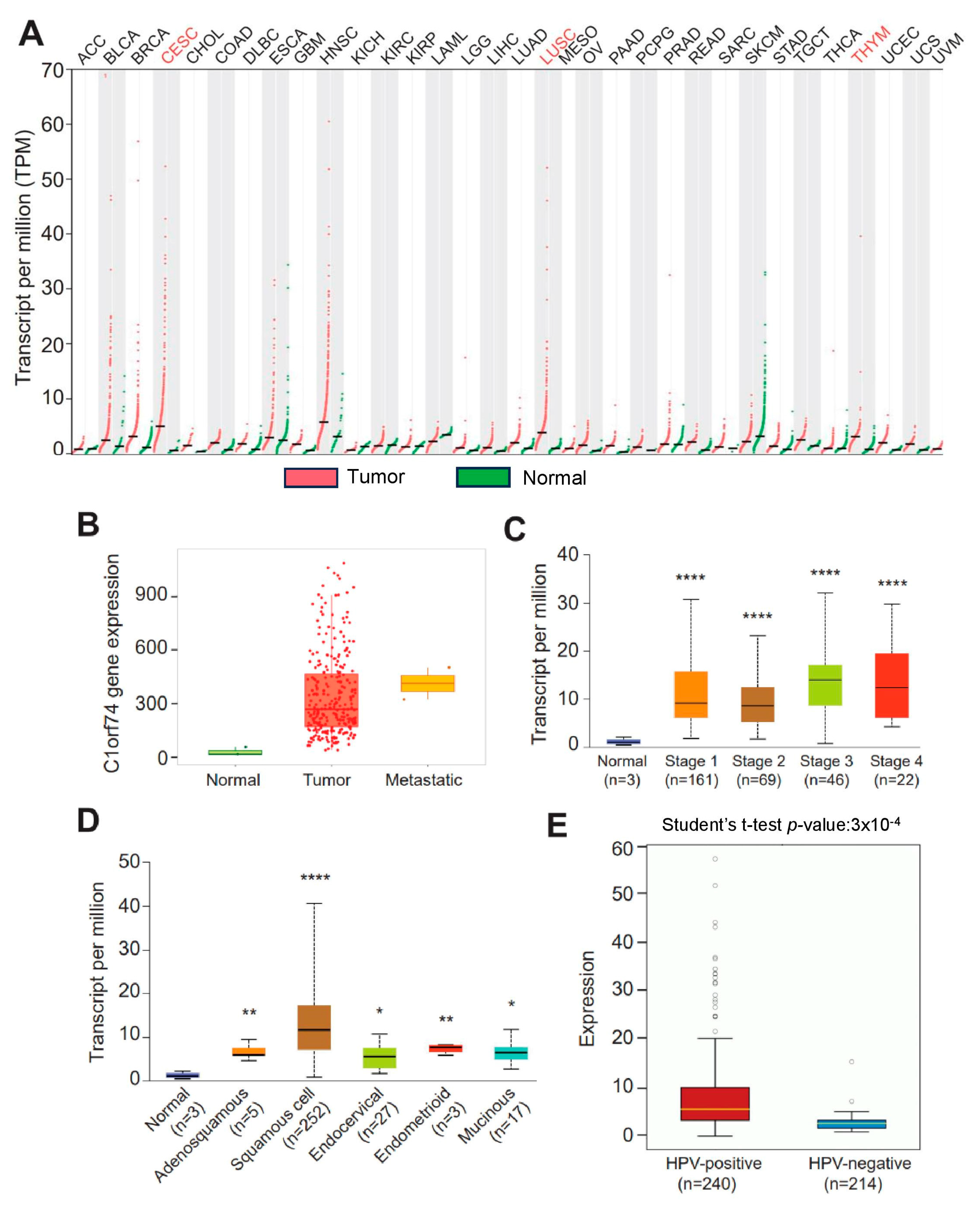
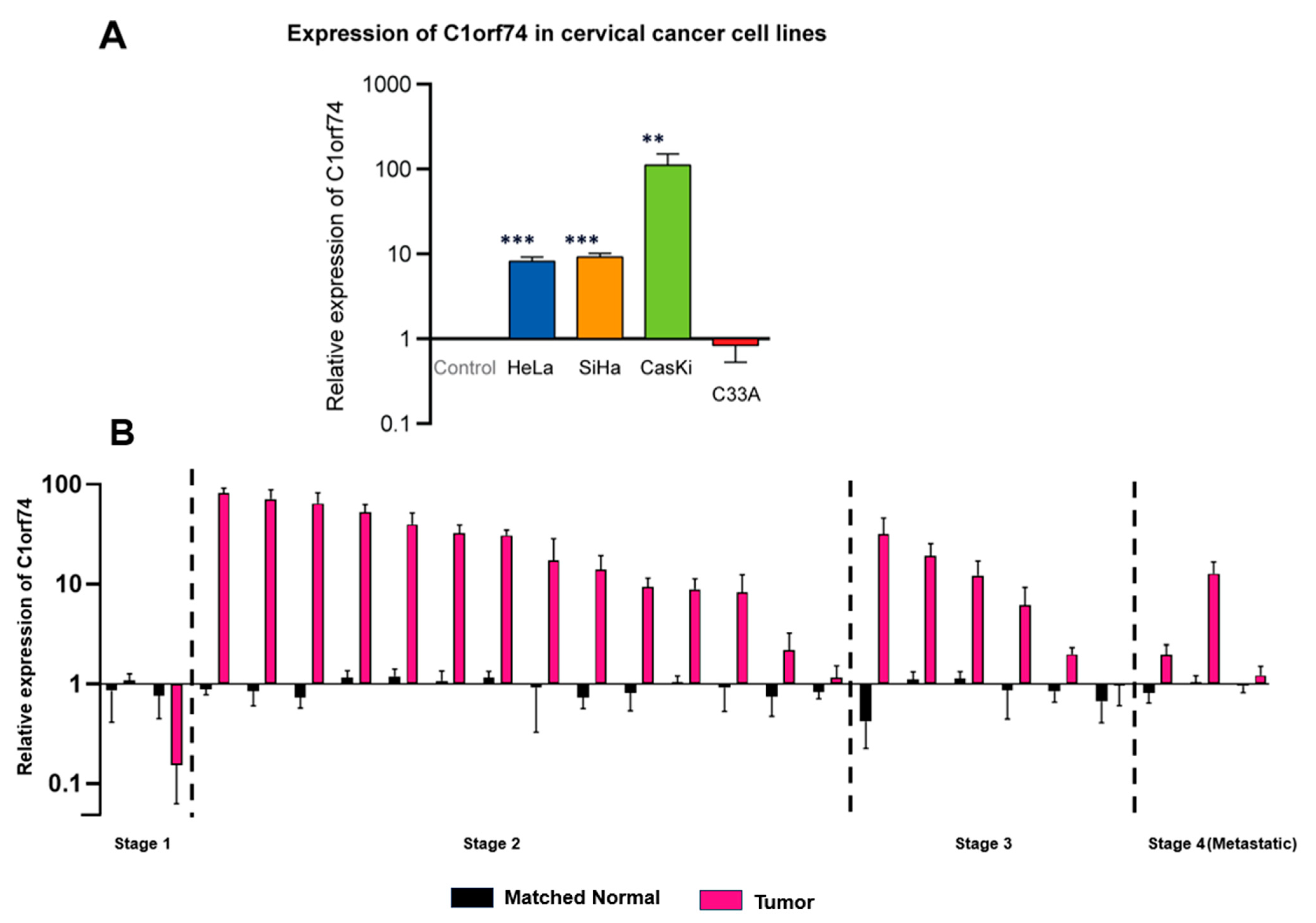
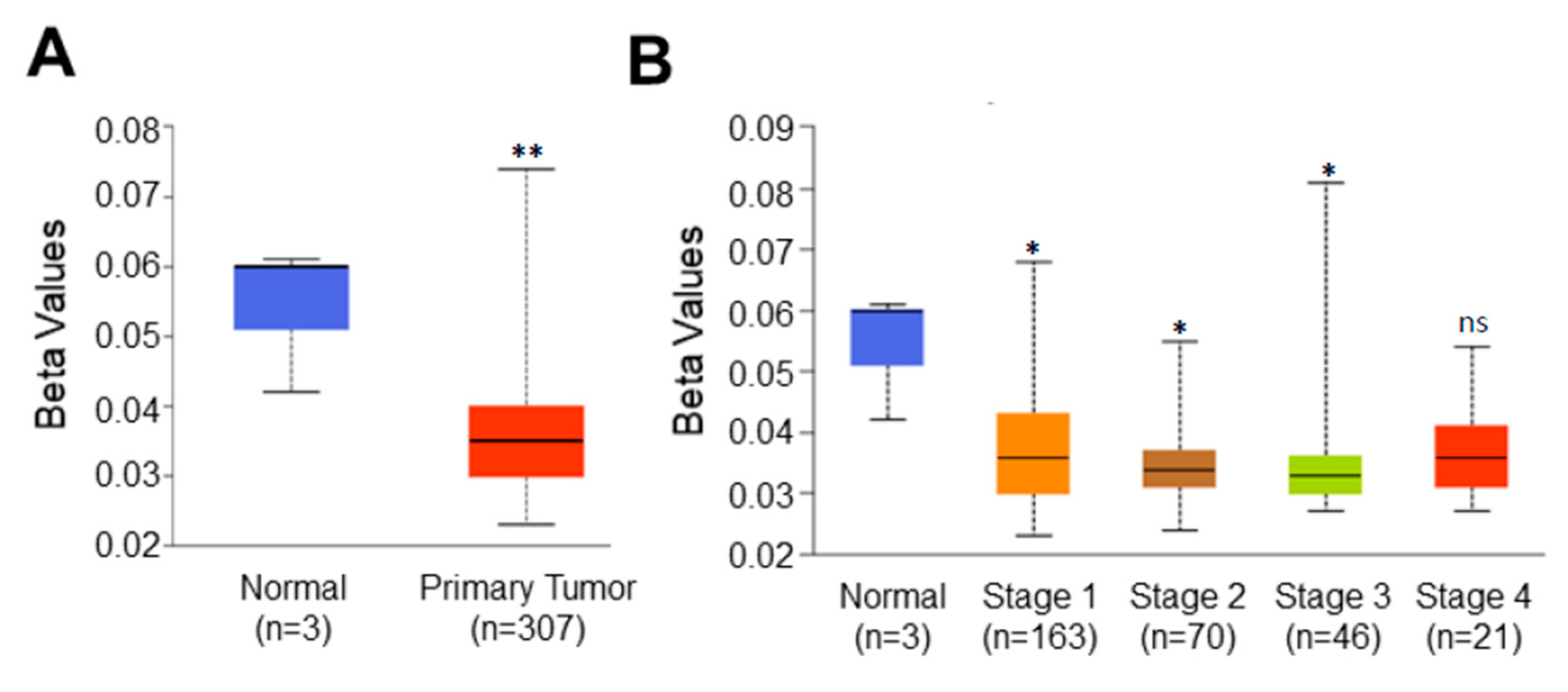
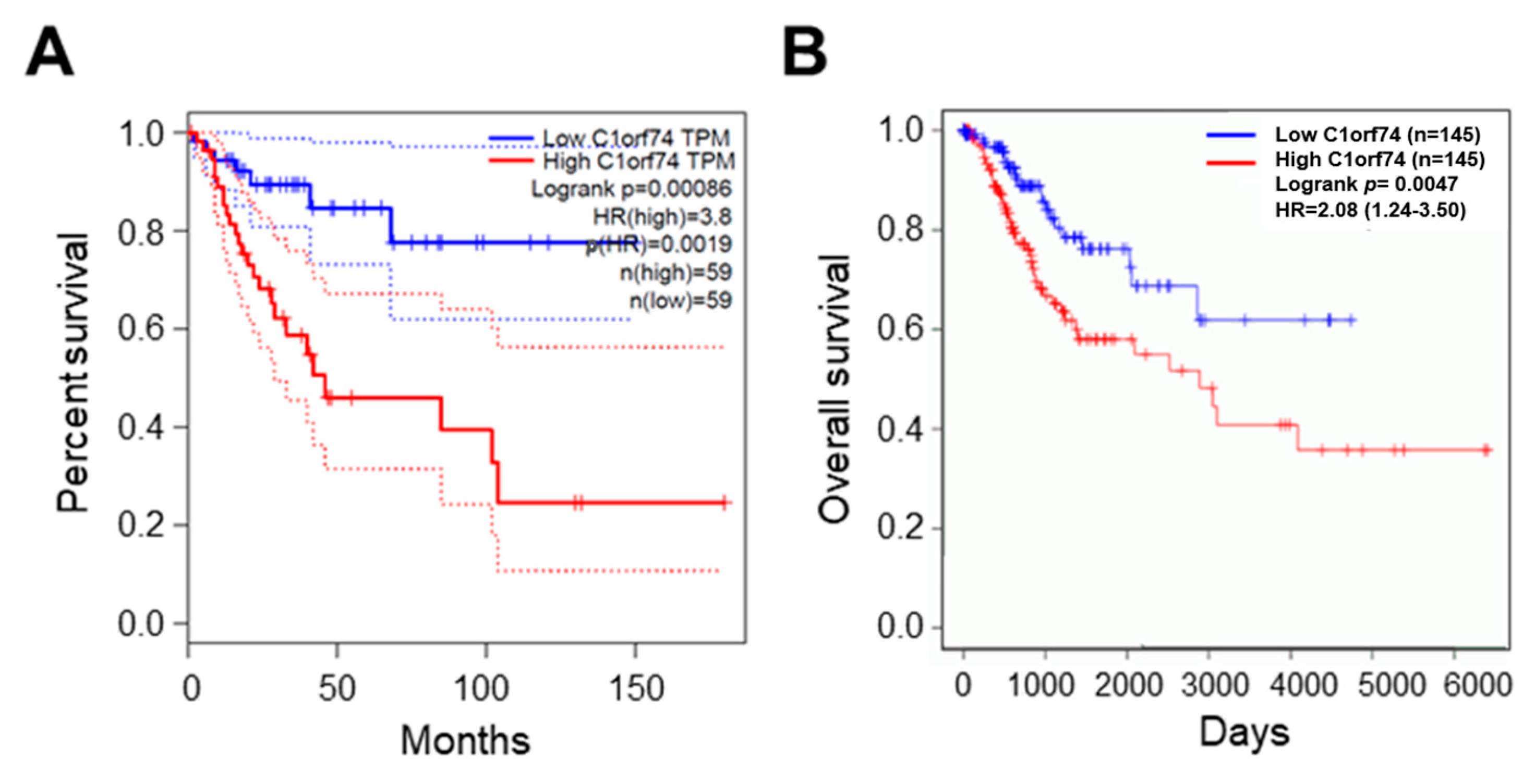
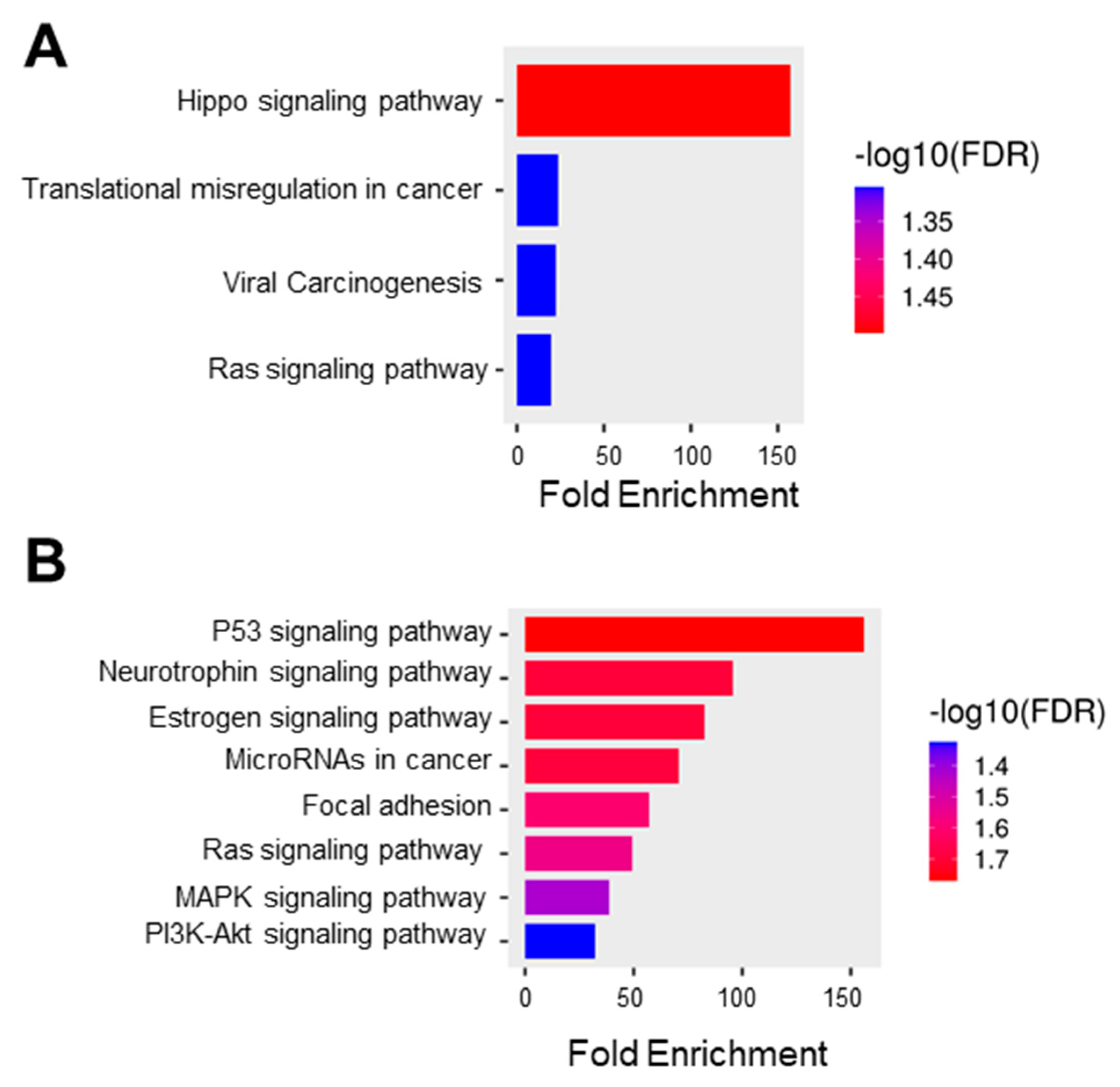
| Patients | n = 25 | |
|---|---|---|
| Age | ||
| Median | 52 years | |
| Range | 38–73 years | |
| Race | Indian | |
| Ethnicity | South Indian | |
| Histology | ||
| Squamous cell carcinoma | 24 | |
| Adenocarcinoma | 1 | |
| Grade | ||
| Squamous cell carcinoma | ||
| Grade 1 | 1 | |
| Grade 2 | 9 | |
| Grade 3 | 6 | |
| Not determined | 8 | |
| Adenocarcinoma | ||
| Grade 2 | 1 | |
| Stage | ||
| 1 | 3 | |
| 2 | 13 | |
| 3 | 6 | |
| 4 (metastatic) | 3 | |
| HPV | ||
| Positive | 25 | |
| Negative | 0 | |
| HPV type | ||
| HPV16 | 22 * | |
| HPV18 | 2 | |
| HPV 31 | 1 | |
| HIV | 0 | |
| HBV | 0 | |
| HCV | 0 | |
| Presenting complaints | ||
| White discharge per vaginum | 13 | |
| Pain (abdominal/suprapubic) | 13 | |
| Post-menopausal bleeding | 11 | |
| Bleeding per vaginum | 4 | |
| Foul-smelling discharge per vaginum | 3 | |
| Postcoital bleeding | 3 | |
| Urinary symptoms | 2 | |
| Hematuria | 1 | |
| Loose motions | 1 | |
| Pyometra | 1 | |
| Spotting | 1 | |
| Comorbidities | ||
| Hypertension | 5 | |
| Diabetes mellitus | 3 | |
| Obesity | 2 | |
| Anemia | 2 | |
| Hydroureteronephrosis | 2 | |
| Depression | 1 | |
| Hypothyroidism | 1 | |
| Acute kidney injury | 1 | |
| Total knee replacement | 1 | |
| L4-L5 intervertebral disc prolapse | 1 | |
| Nil comorbidities | 12 |
| SL No. | Gene | Log Rank p-Value | High Expression: Median Survival (in Days) | Low Expression: Median Survival (in Days) |
|---|---|---|---|---|
| 1 | EREG | 2.80 × 10−6 | 1245 | NA |
| 2 | SLN | 3.70 × 10−6 | 1186 | NA |
| 3 | C1orf74 | 4.20 × 10−6 | 1372 | NA |
| 4 | PCDHB17 | 4.30 × 10−6 | 955 | 4086 |
| 5 | SCAND3 | 9.80 × 10−6 | 1186 | 4086 |
| 6 | ANKRD34B | 1.06 × 10−5 | NA | 2520 |
| 7 | ESM1 | 1.25 × 10−5 | 1011 | NA |
| 8 | PAPPA | 2.04 × 10−5 | 1065 | NA |
| 9 | LOC90586 | 5.06 × 10−5 | 1210 | NA |
| 10 | ZNF134 | 5.29 × 10−5 | 1186 | NA |
Disclaimer/Publisher’s Note: The statements, opinions and data contained in all publications are solely those of the individual author(s) and contributor(s) and not of MDPI and/or the editor(s). MDPI and/or the editor(s) disclaim responsibility for any injury to people or property resulting from any ideas, methods, instructions or products referred to in the content. |
© 2023 by the authors. Licensee MDPI, Basel, Switzerland. This article is an open access article distributed under the terms and conditions of the Creative Commons Attribution (CC BY) license (https://creativecommons.org/licenses/by/4.0/).
Share and Cite
Parida, P.; Lewis, S.; Sharan, K.; Kamal, M.V.; Kumar, N.A.N.; Godkhindi, V.M.; Varambally, S.; Rangnekar, V.M.; Rao, M.; Damerla, R.R. Increased Gene Expression of C1orf74 Is Associated with Poor Prognosis in Cervical Cancer. Cells 2023, 12, 2530. https://doi.org/10.3390/cells12212530
Parida P, Lewis S, Sharan K, Kamal MV, Kumar NAN, Godkhindi VM, Varambally S, Rangnekar VM, Rao M, Damerla RR. Increased Gene Expression of C1orf74 Is Associated with Poor Prognosis in Cervical Cancer. Cells. 2023; 12(21):2530. https://doi.org/10.3390/cells12212530
Chicago/Turabian StyleParida, Preetiparna, Shirley Lewis, Krishna Sharan, Mehta Vedant Kamal, Naveena A. N. Kumar, Vishwapriya M. Godkhindi, Sooryanarayana Varambally, Vivek M. Rangnekar, Mahadev Rao, and Rama Rao Damerla. 2023. "Increased Gene Expression of C1orf74 Is Associated with Poor Prognosis in Cervical Cancer" Cells 12, no. 21: 2530. https://doi.org/10.3390/cells12212530
APA StyleParida, P., Lewis, S., Sharan, K., Kamal, M. V., Kumar, N. A. N., Godkhindi, V. M., Varambally, S., Rangnekar, V. M., Rao, M., & Damerla, R. R. (2023). Increased Gene Expression of C1orf74 Is Associated with Poor Prognosis in Cervical Cancer. Cells, 12(21), 2530. https://doi.org/10.3390/cells12212530







